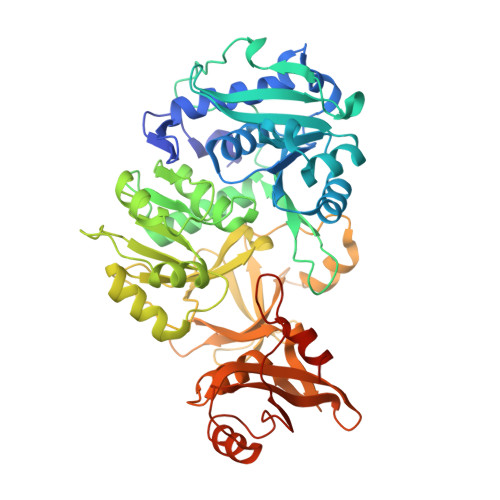Asymmetric horseshoe-like assembly of peroxisomal yeast oxalyl-CoA synthetase.
Burgi, J., Lill, P., Giannopoulou, E.A., Jeffries, C.M., Chojnowski, G., Raunser, S., Gatsogiannis, C., Wilmanns, M.(2023) Biol Chem 404: 195-207
- PubMed: 36694962
- DOI: https://doi.org/10.1515/hsz-2022-0273
- Primary Citation of Related Structures:
8AFF, 8AFG, 8ATD - PubMed Abstract:
Oxalyl-CoA synthetase from Saccharomyces cerevisiae is one of the most abundant peroxisomal proteins in yeast and hence has become a model to study peroxisomal translocation. It contains a C-terminal Peroxisome Targeting Signal 1, which however is partly dispensable, suggesting additional receptor bindings sites. To unravel any additional features that may contribute to its capacity to be recognized as peroxisomal target, we determined its assembly and overall architecture by an integrated structural biology approach, including X-ray crystallography, single particle cryo-electron microscopy and small angle X-ray scattering. Surprisingly, it assembles into mixture of concentration-dependent dimers, tetramers and hexamers by dimer self-association. Hexameric particles form an unprecedented asymmetric horseshoe-like arrangement, which considerably differs from symmetric hexameric assembly found in many other protein structures. A single mutation within the self-association interface is sufficient to abolish any higher-level oligomerization, resulting in a homogenous dimeric assembly. The small C-terminal domain of yeast Oxalyl-CoA synthetase is connected by a partly flexible hinge with the large N-terminal domain, which provides the sole basis for oligomeric assembly. Our data provide a basis to mechanistically study peroxisomal translocation of this target.
Organizational Affiliation:
European Molecular Biology Laboratory, Hamburg Unit, Notkestrasse 85, D-22607 Hamburg, Germany.














